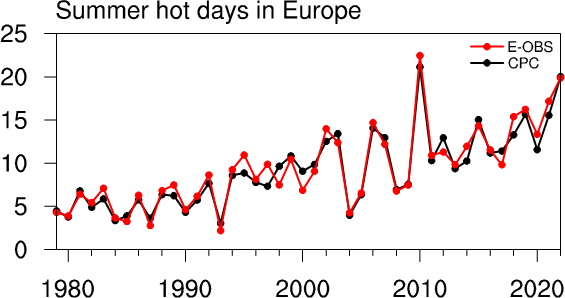Extreme heat event is becoming a “silent killer” in Europe, igniting wildfires while quietly driving up mortality rates. Over the past few decades, summer heatwaves in Europe have grown increasingly severe, with temperatures rising at twice the global average. The deadly 2003 heatwave remains deeply unsettling: it directly caused approximately 30 000 deaths and resulted in agricultural losses in Europe of up to €13 billion. This critical situation has made the driving mechanisms and impacts of extreme heat events in Europe a key focus of scientific research.
A new study conducted by Professor Song Yang and Dr. Lianlian Xu from Sun Yat-sen University, China, reveals a significant interdecadal shift in European summer hot days around 1998. These results have recently been published in Atmospheric and Oceanic Science Letters.
Multiple observational datasets collectively reveal that the number of hot days (NHD) in Europe show a significant interdecadal increase from 1979 to 2022. Analysis of the underlying mechanisms shows that this interdecadal intensification can be attributed to the combined influence of large-scale atmospheric circulation and regional land–atmosphere processes.

Time series of summer hot days in Europe derived from the CPC and E-OBS datasets. Credit: Lianlian Xu.
The period from 1979 to 2022 saw a transition in the Atlantic Multidecadal Oscillation (AMO) from a negative to a positive phase, which can generate a Rossby wave train, resulting in an anomalous equivalent barotropic high-pressure structure and descending motions over Europe, providing a favorable condition for the NHD. On the other hand, soil moisture decreased over Europe, which intensified the land–air coupling strength and consequently resulted in enhanced hot days.
“Summer NHD is typically associated with a high-pressure system and deep descending motions. Such an atmospheric circulation pattern inhibits precipitation but enhances evapotranspiration, consequently leading to reduced soil moisture. That is, local soil moisture is governed by large-scale atmospheric circulations, which can be modulated by remote climate signals. Based on a dynamic adjustment approach, the atmospheric circulation anomalies over Europe linked to the AMO phase transition reduce regional soil moisture by approximately 35%,” explains Prof. Song Yang.
Few studies have been conducted to quantify the contribution of remote signals to local soil moisture. This study provides a new insight into the linkage between the ocean, soil moisture, and hot days, which is essential for understanding extreme heat events worldwide.
Citation:
Lianlian Xu, Song Yang, 2025. Unveiling remote and local drivers for the interdecadal shift of European hot days. Atmospheric and Oceanic Science Letters, https://doi.org/10.1016/j.aosl.2025.100732.
|